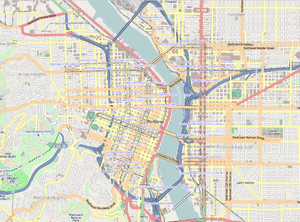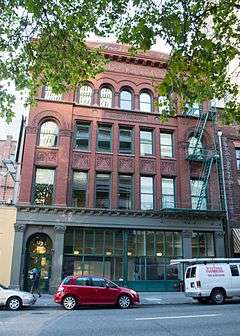Auditorium and Music Hall
|
Auditorium and Music Hall | |
|
The building's exterior in 2013 | |
 | |
| Location | Portland, Oregon, USA |
|---|---|
| Coordinates | 45°30′59″N 122°40′34″W / 45.51650°N 122.67620°WCoordinates: 45°30′59″N 122°40′34″W / 45.51650°N 122.67620°W |
| Built | 1895 |
| Architect | Frederick Manson White |
| NRHP Reference # | 80003357 |
| Added to NRHP | 22 February 1980 |
The Auditorium and Music Hall is an historic building in Portland, Oregon, in the United States, designed by an English architect Frederick Manson White. It was built by Emil C. Jorgensen[1] and was completed in 1895. The building is listed on the National Register of Historical Places.
History
The Auditorium and Music Hall building held several purposes throughout its lifetime. Built for Emil C. Jorgenson in 1895, the first floor was as a liquor wholesale business, the second floor was used for the dance hall, and the third floor was used for a mini concert hall. The next owner renovated the third floor grand space into apartments, and the dance hall into a boxing gymnasium. It remained this way from 1920-1960.[1] Around the 1980’s the architectural firm Boutwell, Gordon, Beard, Grimes,[1] invested $2 million to update and renovation the building. They renovated the first floor to resemble what it originally had looked like after White first built it; they created offices on the second and third floor for their own personal use, and used the top floor to lease to professional offices.[1]
Description
.jpg)
Located downtown Portland, near the waterfront area on lot 6, block 23,[2] the Auditorium and Music Hall building is on the East side of SW Third St., in the middle of the block between Salmon and Taylor.[2]
The foundation of this four story, rectangular building, is composed of pilings, concrete footings and brick piers. Walls and arches support the first floor of timber, while iron columns support the second floor of concrete and wood.[2] The roofing is based with timber trusses that cover the width of the building; creating space for the concert room’s high ceilings. The high ceilings demonstrate an attractive cove ceiling over a "space 27ft high, 42ft wide, and 72ft long.”[2]
The building itself incorporates Romanesque Revival style evidenced in the design of its façade, which was influenced by some works produced by Louis Sullivan, Frank Lloyd Wright, and Henry Hobson Richardson. The terra cotta detailing on the façade is notable on the side arch capitals on the third floor; and “the plant motifs organized in geometric patterns display the strong influence of Louis Sullivan, a significant aspect of these decorative elements is their variety.”[2] This is seen directly on the stone capitals at the first level.
White used this influence in the Auditorium building and it is seen in the similar description used to understand the Richardsonian Romanesque Revival style. Described as “interspersed with other coloured stones to accentuate doorways and windows. Rectangular blocks with little ornaments other than the play of voids and solids across the surface project enormous power and a sense of timelessness.”[3] Which is seen in the design of the Auditorium Building's façade.
Historical significance
Social life in Portland reflected heavily on the purpose and design Frederick White incorporated in the Auditorium Building. During the 1840’s and continuing into the 1880’s the population of Portland increased. As the city grew, the population developed a taste for various refined social and cultural activities.[4] These activities starting in the 1850’s included music, theater, “parties, candy pulls, church socials, [and] dances”.[4] The population increase and enjoyment of these activities easily expanded throughout the city because of the completion of Portland’s first transcontinental railway in 1883.[4] It improved traveling performances, drawing more to the Portland area to satisfy the intense desire for it.
Throughout the city of Portland several different types of theaters were developed to best fit the varieties of plays and operas that were traveling to perform in the city. By the year 1890, “Portland had six good-sized theaters with a total seating capacity of about 6,200. It also had a number of smaller places featuring various types of popular entertainment”.[5] The Auditorium, being one of these smaller buildings, catered to smaller performances. White’s intentional inclusion of an auditorium and dance hall into the design was done directly to accommodate the social desires and attractions fitting to the era in which it was built.
The Architect
Frederick Manson White: Born in Derby, England on March 18, 1863.[6] He studied architecture in Paris, France at the École des Beaux-Arts where he adopted French, English, and Spanish styles of architecture. White was called to Portland, Oregon where he established a name for himself in the field of architecture. He is most famously known for buildings throughout the Portland area such as the Portland armory, First Presbyterian Church, the Dekum building, and the Imperial Hotel.[6] The Auditorium Building was his first independently commissioned project, and his design of the auditorium building stands as a testament to his skill and imagination as an architect.
National Register of Historical Places
The Auditorium building was nominated by the Portland Historical Landmark Committee, and placed on this list in February 1970[7] to protect it from future renewal. It became apart of the National Register of Historical Landmarks because of the buildings representation and connection to the Romanesque revival style. The significance of the design and its physical location in downtown Portland, the National Register of Historical Places deemed the Auditorium and Music Hall historically relevant. Which is why it can still be found on SW 3rd Ave downtown Portland.
See also
References
- 1 2 3 4 Janet Gotetze. "Auditorium Style Reclaimed.” The Oregonian. Newspaper. 3 April 1983. Vertical File A: Portland Buildings. The Oregon Historical Society Davies Family Research Library. Accessed 21 October 2016. 35
- 1 2 3 4 5 “Portland Oregon Historical Landmark Comission.” Manuscript. February 1970. Verticle File A: Portland Buildings. The Oregon Historical Society Davies Family Research Library. Accessed 20 October 2016.
- ↑ L. E. Panayotids. (1991). Gothic and Romanesque: A question of style. The arrangement of Protestant churches and school houses in 19th century Ontario: The work of Henry Langley. York University (Canada).
- 1 2 3 Paul Gilman Merriam. (1971). Portland, Oregon, 1840-1890: A Social And economic History. University of Oregon. Ann Arbor.145.
- ↑ Paul Gilman Merriam. (1971). Portland, Oregon, 1840-1890: A Social And economic History. University of Oregon. Ann Arbor.155.
- 1 2 “Frederick Manson White Geneaology.” Typed Script. April 24, 1952. Vertical File A: Portland Buildings. The Oregon Historical Society Davies Family Research Library. Accessed 20 October 2016.
- ↑ “920 S.W. Third Ave.” Undated record. Historic Resource Inventory: City of Portland Oregon. Oregon Historical Society Davies Family Research Library. 21 October 2016.
External links
-
 Media related to Auditorium and Music Hall at Wikimedia Commons
Media related to Auditorium and Music Hall at Wikimedia Commons - NRHP Nomination Form
